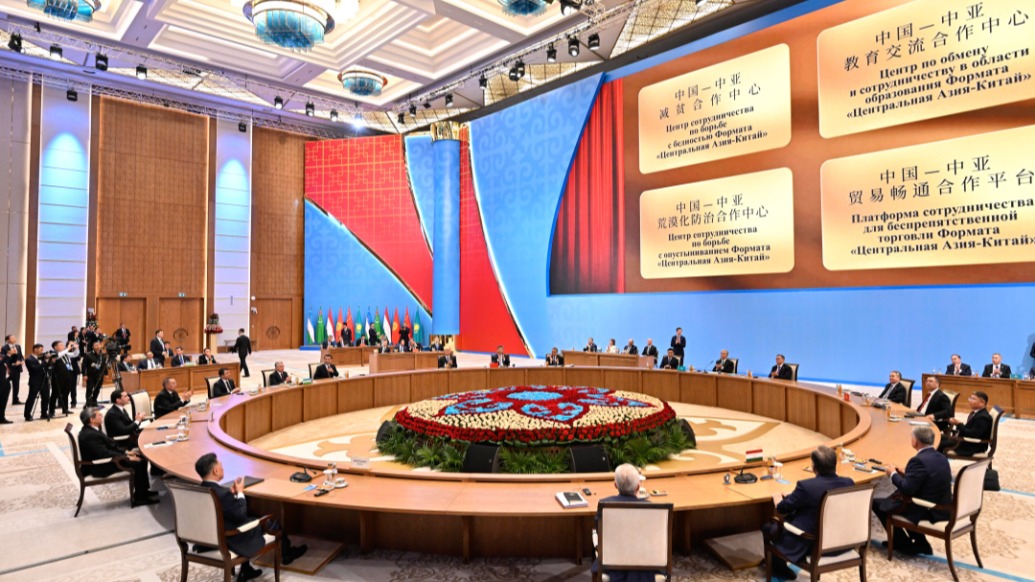
Tranalysis

On the afternoon of June 17th local time, the second China-Central Asia Summit was held at the Independence Palace in Astana. President of Kazakhstan Tokayev presided over the meeting
From June 16-18, 2025, the second China-Central Asia Summit was held in Astana, the capital of Kazakhstan. The most
Firstly, mutual respect and equal treatment are the basic prerequisites for China and Central Asian countries to handle their mutual relations, and also set an example for interactions between countries under new circumstances.
In today's era, unilateralism and protectionism have seen a resurgence, and hegemonism and power politics have intensified their impact. How to maintain the rights and dignity of countries of all kinds has become a multiple-choice question that all countries must answer. Whether it is arrogance and bullying, or stubbornness and oppression, both are destructive to the norms of relations between countries and destructive to the ecological environment of relations between countries. Although China and Central Asian countries vary in size and overall strength, they all recognize that countries should be treated equally regardless of size, and that decisions should be made through consultation and consensus. This is fundamentally different from some countries that often use \position of strength\ as an excuse for hegemonic actions and \interests\ as a basis for selfish behavior.
This principle is reflected in the \Astana Declaration\ as China and Central Asia \mutually understand, respect, and support each other on issues involving their respective core interests\; China and Central Asian countries sign the \Treaty on Good-Neighborliness, Friendship, and Cooperation\ to establish a permanent, all-weather, and comprehensive strategic partnership, which is also due to the consistent adherence to the premise of \mutual respect\ in the development of relations.
Secondly, deepening mutual trust and responding in unison are key principles in promoting the development of relations between China and Central Asian countries, and also lay the foundation for enhancing regional cooperation levels.
China's relations with Central Asian countries over the past three decades have shown that there are many common interests among the six nations, as well as numerous differing interests. The key experience in promoting cooperation among all parties in areas of common interest and avoiding conflicts in the face of differing interests, thereby ensuring the long-term and healthy development of mutual relations, is to take mutual trust as a principle, firmly support each other in maintaining national independence, sovereignty, territorial integrity, and national dignity, and not do anything that harms each other's core interests. In this process, China has always regarded Central Asia as a priority in its peripheral diplomacy, adhering to the principles of good-neighborliness, amity, mutual benefit, and inclusiveness, interacting with Central Asian countries on an equal and sincere basis, and fostering closeness and goodwill among neighbors. This principle is reflected in the \Treaty of Eternal Good-Neighborliness, Friendship, and Cooperation\ as \comprehensively developing a long-term and stable strategic partnership based on the principles of mutual respect for sovereignty and territorial integrity, non-aggression, non-interference in internal affairs, equality and mutual benefit, and peaceful coexistence.\
Once again, mutual benefit and win-win, common development is the practical guarantee for the continuous improvement of relations between China and Central Asian countries, and also provides support for the development of China and the Central Asian region.
Over thirty years of hard work and perseverance, China and the five Central Asian countries have achieved comprehensive strategic partnerships, joint construction of the \Belt and Road\ cooperation partners, and the \three全覆盖\ of bilateral and regional community of shared future. After the proposal of the \Belt and Road\ initiative, China and Central Asian countries have taken the joint construction of the \Belt and Road\ as the main thread, with trade and investment booming, major projects following one after another, and interconnectivity being accelerated, forming a pragmatic, efficient, and deeply integrated cooperation pattern. The China-Central Asia mechanism, jointly established by the six countries five years ago, has also shown vigorous vitality and achieved rapid development. Especially after the successful holding of the first summit in Xi'an in 2023, the construction of this mechanism quickly took shape, with 13 ministerial cooperation platforms established one after another, and the permanent secretariat fully operational, presenting a multi-level and diverse cooperation pattern led by heads of state, driven by governments, participated by all sectors, and multi-track parallel.
This year's second summit held in Astana saw China and the five Central Asian countries not only issue the \Astana Declaration\ and sign the \Treaty on Eternal Good-Neighborliness, Friendship, and Cooperation,\ but also reach a series of cooperation consensuses, including 55 cooperation documents, 21 cooperation initiatives and proposals, and 24 important activities. This has charted the direction for practical cooperation between China and Central Asia. The heads of the six countries jointly declared 2025-2026 as the \Year of High-Quality Development of China-Central Asia Cooperation.\ China and Central Asian countries will focus on six priority areas: trade facilitation, industrial investment, connectivity, green mining, agricultural modernization, and people-to-people exchanges, to achieve more tangible outcomes and support each other's development and revitalization.
It is precisely because of cooperation guided by mutual benefit and win-win that China and Central Asian countries, as fellow travelers on the path to modernization, can work together to promote genuine development and prosperity.
Finally, mutual assistance and solidarity are the solid pillars for China and Central Asian countries to withstand shocks, safeguarding the security and stability of China and the Central Asian region.
At present, the international environment is turbulent and unstable, with a once-in-a-century major shift accelerating its evolution, ushering the world into a new period of change and uncertainty; at the same time, within the Central Asian region, issues such as the \three forces,\ economic and social dilemmas, and resource and ecological pressures are intertwined, posing multiple complex challenges to regional cooperation. Faced with such pressures, China and Central Asian countries emphasize the need to jointly safeguard regional peace and security stability by strengthening the regional security governance system, deepening cooperation in law enforcement, and jointly resisting the infiltration of extremist ideologies.
The second China-Central Asia Summit held in Astana has clearly responded to the aforementioned challenges. Both the \Astana Declaration\ and the \Treaty on Eternal Good-Neighborliness and Friendly Cooperation\ deeply express the common desire and firm determination of China and the five Central Asian countries to defend their shared security. The speeches of Chinese and Central Asian leaders also emphasized combating the \three forces,\ deeply preventing the infiltration of cross-border terrorism, drug trafficking, and organized transnational crime, and building a more solid security barrier. At the same time, China has promised to assist in the construction of rule of law and cybersecurity capabilities within the region, strengthen law enforcement cooperation, enhance security response capabilities, and jointly create a peaceful development environment.
More importantly, this summit reiterated \supporting each other in following development paths that suit their national conditions and managing their own affairs well,\ which means that China and Central Asian countries adhere to mutual respect and sovereign equality on security issues, and stand shoulder to shoulder to face risks. In addition, the multiple cooperation documents signed by China and Central Asian countries at this summit, as well as the various cooperation measures and initiatives proposed, have provided both sides with more synergy and focal points in the field of security governance, which is conducive to China and Central Asia jointly creating a security and stable environment conducive to development.
In general, China and Central Asia, guided by the spirit of \rowing the boat together,\ carry out cooperation from tactical to strategic levels, which is the fundamental way to effectively address common security challenges; China and Central Asian countries build a pragmatic and efficient cooperation framework based on this, which can not only enhance the level of security governance and continue to escort regional peace and development, but also set an example for the international community to address global and regional security challenges through institutionalized collaboration.
In summary, the second China-Central Asia Summit is not only an important milestone in the development of China-Central Asia relations. The \China-Central Asia spirit\ with \mutual respect, mutual trust, mutual benefit, and mutual assistance, promoting common modernization with high-quality development\ as its core, proposed and explained by President Xi Jinping, has pointed the way for future China-Central Asia cooperation. At present, when unilateralism and hegemonism are on the rise and the global situation is full of uncertainty, China and the five Central Asian countries have signed the \Astana Declaration\ and the \Treaty on Eternal Good-Neighborliness, Friendship, and Cooperation\. Based on this, they have built a framework of deep mutual trust and strategic cooperation to promote cooperation in security, trade, and cultural fields, turning the \China-Central Asia spirit\ from an idea into specific actions. They have created a new model of international relations characterized by equal consultation, mutual trust and cooperation, joint construction and sharing, and overcoming difficulties together. This not only sets an example for future cooperation between China and the Central Asian region but also provides new insights for global cooperation.
(Ma Bin, Associate Researcher at the Institute of International Studies, Fudan University)




